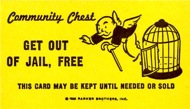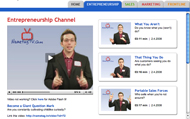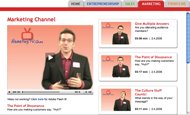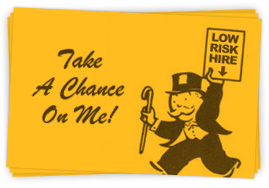 The best part about playing Monopoly was drawing a chance card.
The best part about playing Monopoly was drawing a chance card.
It was risky.
It was exciting.
It was the only way to beat my older brother.
MORE IMPORTANTLY: Chance Cards taught kids that life without risk, isn’t.
What chances are you avoiding?
Consider this list of ten chances worth taking: 1. Every interaction is another chance to give. Charisma is irrelevant when people walk away from you feeling more in love with themselves. That’s the greatest gift you can give people: To be a mirror. To give them a front row seat to their own brilliance.
Every time I interact with someone, I go out of my way to write down at least one thing they’ve said into my pocket jotter. And always right in front of them, too. It makes them feel heard, quotable and smart. What gifts are known for giving?
2. Every mistake is another chance to evolve. Winning is boring because you never learn as much. Personally, I’d rather screw up. It builds character and makes for a much better story. Besides, you can’t win if you refuse to make failure a regular part of your experience.
People who tell you failure isn’t an option need to have their vision checked. The goal is to fail and fail and fail some more, learn and learn and learn some more, and then win and win and win some more. Are you ready to endure the failure that growth requires?
3. Every sentence is another chance to bleed. As a writer, my job is to put my entire world into everything I write. That way, every sentence is a piece of my truth. Every sentence has a story behind it. Every sentence provides experiential value at the point of consumption. Every sentence deliberately sets out to make the reader blink.
And, every sentence holds up a mirror that demands people look at themselves. In my experience, when you approach writing in that way, your material connects with readers in a personal, relevant and emotional way. How bloody is your art?
4. Every decision is another chance to matter. When Alfred Nobel’s brother died, several newspapers accidentally published his obituary instead. He was remembered as, “The merchant of death who became rich by finding ways to kill more people faster than ever before.”
Devastated, Nobel spent the next seven years making sure he left a legacy that mattered. And then, one year before his death, he created the most prestigious award in human history. Looks like he made the right decision. That’s the whole thing about mattering: The people who do so are the ones who choose so. Who is thanking you for making that choice?
5. Every anxiety is another chance to inhale. Yoga has doubled my pain tolerance. For serious. Thanks to my practice, when I experience moments of discomfort, waves of anxiety, even bonafide bouts of physical agony, I’ve trained myself to breathe through it.
Which doesn’t make the pain go away, it just changes your relationship to the experience of it. Turns out, when you greet the pain with a welcoming and thankful heart, you can use its momentum against itself to convert it into a meditation. When was the last time you gave thanks for your discomfort?
6. Every customer is another chance to research. Even if the customer is unprofitable. Even if the customer is a pain in the ass. Even if the customer is someone you hope takes a long walk off a short pier. Every one of them is a walking case study. Every one of them has the potential to make you smarter.
Listen to them. Loudly. Rejection is cheaper than silence. And don’t forget to take notes, too. Because these people will happily tell you what to sell to them – and how to sell it. Probably not through words, but they’ll still tell you. Whose feedback are you listening to?
7. Every question is another chance to catapult. My presentations overflow with disturbing questions. Not because I want people to answer them, but because I want to flip a mental switch inside their heads.
That’s the mark of a good question: Once you hear it, you’re changed forever. Once you hear it, you can’t get it out of your head. And once you hear it, you begin to answer it with your life.
Next time you attend another pointless department meeting, see if you can ask the most disturbing question of the day. Because it only takes one moment of stunned silence to change everything. What questions are you known for?
8. Every accident is another chance to leverage. Leverage is the bridge between occurrence and opportunity. And since everything unfolds regardless of how we feel, it all depends on how you approach what happens to you.
First, get good at recognizing when life is giving you a gift. Listen to your unintentional music. That way, you can convert accidents into advantages. Next, get good and calmly coping with inconvenience. Instead of fighting or flighting – try friending. It’s much easier to respond to the crap the world hurls at you.
And last, view accidents as adventures and not ordeals. Try making a list of every good thing that will come from change. Do you welcome every opportunity to build resilience?
9. Every conversation is another chance to respect. Being an asshole is not a scalable business model. If you want your people to gasp with delight, help them feel more respected every time they deal with you. Learn to see the world through their eyes. And participate in their lives – not just the conversation about their lives.
I’m reminded of my mentors, Arthur and Bill. They’re more than twice my age – and probably thrice my intelligence – yet both of them ask for my advice almost every time we talk. Point is: Respect is the engine of communication. And we can always sense when it starts sputtering. Who have you disrespected this week?
10. Every audience is another chance to shine. Even if it’s only one person – that’s still an audience. We live in an experience economy. And if you’re not willing to invest a little effort in the art of showmanship, customers will take their business elsewhere. To become a hard act to follow, consider these ideas:
First, ask your audiences to take part in the communication of an idea. Instead of expecting passive recipients, demand an active participant. Second, take a moment to make a memory. Burn the service moment into people’s brains. Third, create a verbal incident. Add something to their lives and rewards them for spending time with it. What’s your sharing device?
REMEMBER: Life without risk, isn’t.
Draw a chance card.
It’s the only way to win.
Especially if you’re playing against my older brother.
LET ME ASK YA THIS…
What are you taking chances on?
LET ME SUGGEST THIS…
For the list called, “52 Random Insights to Grow Your Business,” send an email to me, and you win the list for free!
* * * *
Scott Ginsberg
That Guy with the Nametag
Author, Speaker, Publisher, Artist, Mentor
[email protected]
Now booking for 2011-2012!
Watch The Nametag Guy in action here!


 You’ve chosen an uncertain path.
You’ve chosen an uncertain path. Anytime you dare to descend down the unknown path, certain elements will always be at work.
Anytime you dare to descend down the unknown path, certain elements will always be at work.  You’ve chosen an uncertain path.
You’ve chosen an uncertain path. You’ve chosen an uncertain path.
You’ve chosen an uncertain path. I wear a nametag twenty-four seven.
I wear a nametag twenty-four seven.
 I never went to the career fair.
I never went to the career fair.
 People can get information anywhere, anytime, immediately, for free.
People can get information anywhere, anytime, immediately, for free. Gambling is for fools.
Gambling is for fools. Fearless people scare me.
Fearless people scare me.